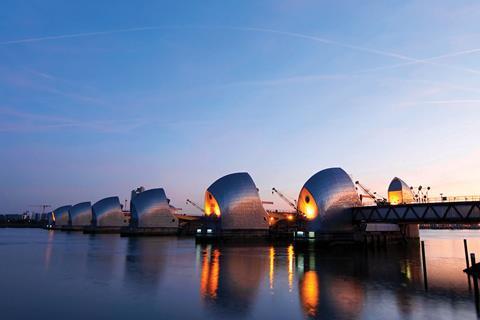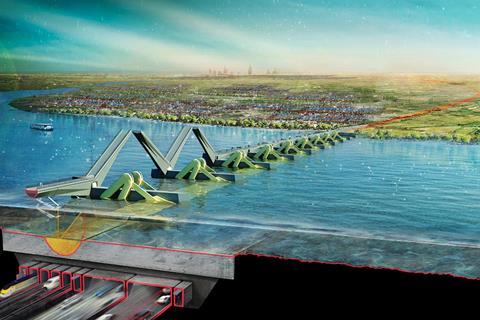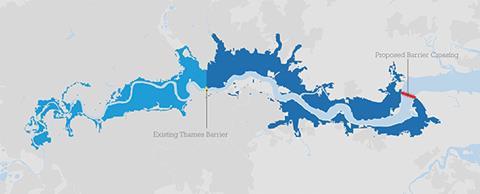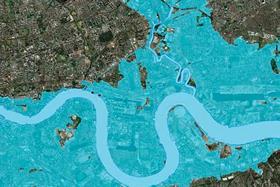With much of the Thames Valley looking like something out of a disaster movie this winter, arguments are raging over whether the Thames Barrier can cope with the consequences of climate change - or whether it’s time to start thinking about building a new one

The preposterous 2007 disaster film Flood which starred Robert Carlyle and depicted London consumed by an apocalyptic tidal surge was plausible in just one sense: were floodwaters ever to overwhelm the Thames Barrier, the effect on London would be cataclysmic. The enormous importance of the Thames Barrier to London’s safety was brought sharply into focus during the floods that wrought havoc across southern and western Britain during what has been the wettest winter on record.
The Thames Barrier was initially designed to be closed on average once every six years and was closed just four times throughout the entire eighties. However, between 8 and 17 February this year, when the floods were at their height, it was closed a record-breaking 20 times.
While for some the very presence of the Thames Barrier and the protection it affords London feeds into the caricature of resentment that they believe proffers preferential treatment to the capital at the expense of the regions, the reality is that a catastrophic natural disaster in a city that houses nearly one seventh of the UK’s population and generates almost a quarter of its entire GDP would have devastating economic and psychological consequences for the entire country.
London is built on one of Europe’s largest tidal floodplains and its history prior to the construction of the barrier provides grim evidence of the city’s vulnerability to flooding. In his famous diaries from the 17th century, Samuel Pepys mentions the Thames “drowning” Whitehall. The last major flood to affect central London was in 1928 when to date, the highest ever water levels on the Thames were recorded.
The Thames Barrier is a marvellous feat of engineering. But it took 30 years to plan and build; we can’t wait until 2070 for a new one, we need to start thinking about it now
Dr Richard Bloore
Record snow and rainfall flooded 100,000 homes in London and the Thames Valley in 1947. But one of Britain’s worst-ever natural disasters occurred in 1953 when the North Sea’s biggest recorded storm surge unleashed devastating floods across London and eastern counties, killing over 300. It was this disaster that initiated the strategic national review of flood defences that culminated in the completion of the Hull Tidal Barrier in 1980 and Thames Barrier in 1983.
The Thames Barrier was built to protect about 46 square miles of central London (just under 8% of London’s total area) from major flooding until 2030. But since its completion our environment has changed.
Climate change, whether cyclical, anomalous or man-made, appears to be a growing threat with major weather events across the world seemingly becoming more violent and frequent, as the barrier’s escalating closure schedule indicates.
Flooding on the scale we have recently witnessed was once classed as a generational occurrence yet similar events took place in 2003, 2007 and 2013. Just last month global risk analysts Maplecroft ranked Britain as the country with the seventh highest economic risk from flooding in the world.
The barrier itself was built to criteria that anticipated a breach once every 2,000 years. But with one-in-a-hundred year floods already having occurred four times this century, the statistical data on which its design was based may already be obsolete.
Moreover, the barrier is increasingly being used to prevent fluvial flooding in west London caused by intense rainfall, as witnessed last month, rather than for its original function of protecting central London from tidal surges in the North Sea. The Thames is tidal up to Teddington Weir in south-west London, 25 miles upstream from the barrier which is located at Woolwich. At high tide when the basin of the Thames is already filled with water, there is greater chance of rainfall causing flooding. By closing the barrier gates at these times, it provides additional room into which potential floodwaters can flow. The waters can then be released into the estuary when the barrier gates are reopened at low tide when the danger has passed.
And of course the spectre of global warming looms large. Global warming was unheard of when the barrier was being planned and built in the sixties and seventies and its design could not possibly have anticipated or accommodated the prospect of melting polar ice caps and rising seas levels.
TB or not TB?

So, do we need to start thinking about a new Thames Barrier? The Environment Agency used to think so but has recently changed its mind. In fact, in its landmark Thames Estuary 2100 (TE2100) report whtich sets out its flood risk management plan over the next century and was published in 2012, it was confirmed that the lifespan of the barrier has now actually been extended from 2030 to 2070.
This however is in marked contrast to pervading environmental and political thought over the past decade. As recently as 2007 at the height of the summer floods that took place that year, then environment minister Phil Woolas thundered that the probability of London flooding had “doubled from a one in 2,000 chance to a one in 1,000 chance.”
He revealed that the government was due to make an “urgent” decision on building a new barrier “within the next year” and further declared that England and London’s exposure to flood risk and extreme weather was no longer an “academic debate but a real threat”.
Barely two years earlier, Environment Agency scientist Peter Borrows revealed that plans for a £20bn 10-mile long Thames Barrier were being considered. It was to be built as a gated embankment structure further east of the existing barrier at the mouth of the Thames Estuary between Southend-on-Sea in Essex and Sheerness in Kent.
The Environment Agency now claims that such development has proved unnecessary due to there being “greater capacity in the current flood management system than had been previously understood”. Furthermore, TE2100 states that the Thames Barrier already has an allowance for sea level rises of up to 8mm per year and as this already exceeds current sea level rises, “the present standard of protection is much higher than originally expected”.
Rather than a new barrier, TE2100 instead proposes a triple-phased maintenance and upgrade programme. Phase 1 will essentially continue current operations until 2034 with additional emphasis on replacing wildlife habitats potentially disrupted by rising sea levels. Phase 2 will see the renewal and replacement of other non-barrier Thames flood defences until 2050. From 2050 onwards TE2100 will be reviewed to ensure that “new arrangements” are in place by the forecast end of the barrier’s current life-cycle in 2070.

For Dr David Vaughan of the British Antarctic Survey, accurate sea level monitoring and projections are essential for the Environment Agency’s new plan to work. “A 50cm rise of base sea level in the Thames Estuary would reduce the [Thames Barrier’s] protection from a breach 1-in-1,000 years, to breach 1-in-100 years. This is not to say that breach is inevitable, just more likely.
“The Environment Agency fully understands these numbers, and has in place a plan on how to maintain levels of protection in the face of various scenarios of sea level rise. To make their plan work, so that we increase protection in good time and provide a level that satisfies the taxpayer, we need good scientifically-sound projections of sea level rise, and monitoring from here on in to ensure that those projections are on track.”
At the moment the Thames Barrier just protects London’s core, but the Spine will also protect the eastern areas beyond Woolwich into which London will inevitably expand
Huw Thomas, Foster + Partners
But not everybody is convinced that the Environment Agency’s new strategy is the right one. Baroness Jones of the Green Party has previously expressed her belief that London urgently needs additional flood protection now to combat climate change, and Dr Richard Bloore, chief project manager on the construction of the original Thames Barrier, is unequivocal in his support for a new barrier, a view that has been reinforced by the recent flooding.
“The Thames Barrier gives London world-class protection and is a marvellous, world-beating feat of engineering. But it took 30 years to plan and build; we can’t wait until 2070 for a new one, we need to start thinking about it now. The recent dreadful weather has been extraordinary, sea levels are rising and weather is clearly becoming more extreme. Who would have thought something like Hurricane Sandy would devastate New York the way it did? London needs to be prepared before it’s too late.
“When the Thames Barrier was designed, we didn’t know about climate change or global warming. We never even anticipated it would be used to prevent fluvial flooding in west London. The environmental criteria we used are completely obsolete. I need a lot of convincing about the Environment Agency’s new strategy -they often seem more concerned about wildlife and habitats than anything else. I’m not saying replace the barrier tomorrow, it’s designed to be fit for purpose up to 2030 and beyond. But surely we have to at least start thinking about what comes next now rather than decades into the future?
A new barrier?
As it happens, somebody has started doing just that. While the Environment Agency might not think we need a new barrier yet, there is a growing body of professionals who think we do. For the past four years architects Foster + Partners and engineers Halcrow have been busy progressing plans for a new hub airport in the Thames Estuary to the east of London. The proposals have been embroiled in the ongoing and as yet unresolved controversy surrounding London aviation capacity expansion, a circumstance which might explain why two key aspects of the plans have been largely overlooked.
The first is that the proposals include a new £6bn Thames Barrier built across the estuary, referred to by its creators as The Spine. And the second is that the new barrier is actually part of a separate, ambitious infrastructure integration programme that can proceed with or without the hub airport and is a critical component of a much wider vision for comprehensive urban regeneration and expansion across the Thames Gateway. As Huw Thomas of Foster + Partners explains: “Our new barrier is as much about connection as it is protection.”
Fosters and Halcrow are proposing a new barrier between Tilbury in Essex and the Hoo Peninsula in Kent, slightly west of the Borrows’ 2005 proposals and approximately 30 miles downstream from the current barrier. Previously the plans indicated a barrier with rotating gates, as at the existing Woolwich barrier. But Thomas reveals that further studies have found that this would be “too restrictive to shipping at Tilbury” so lifting barrier options are now being investigated.
But the really interesting element of this new barrier is that it performs not one function but three. As well as preventing flooding, hydropower generators integrated into the barrier and a floating hydropower array located in the water beside it could generate up to 525GWh of energy per year with zero carbon emissions. This would be enough to power 76,000 of the households earmarked for the Thames Gateway.
The third function would be the new road and rail links integrated into the foundations of the barrier which could form the desperately needed but as yet unrealised Lower Thames Crossing. As Thomas explains, the barrier’s construction makes its utilisation as a transport link an easy option. “We’d build the tunnel components on dry land, dredge a channel across the estuary, drop the boxes in and then build the barrier foundations around them.”
But for the design team, the key achievement of this transport element would be to provide a fully integrated transport system with the rest of the country that, by means of a planned new orbital railway around London (another related proposal) has the potential to transform road, rail, freight and trade routes across Britain and beyond. As part of this vision, the barrier would also be located adjacent to the new London Gateway Port which will eventually be one the world’s biggest shipping ports and contain the largest logistics park in Europe.
For Thomas, the new barrier solves a multitude of problems. “The Environment Agency somehow estimate that the current barrier will protect London until 2070 but that’s based on what we know now, it doesn’t incorporate what we may learn in the future. At the moment the Thames Barrier just protects London’s core, but the Spine will also protect the eastern areas beyond Woolwich into which London will inevitably expand.

“It thereby removes flood risk from a huge area of the Thames Gateway, enabling the massive development of the 200,000+ homes needed to proceed without the insurance risk that we have already seen spark a debate in the other flooded areas of the country. We’ve also carefully placed the barrier at a bend in the river that allows it to be easily integrated into national and global infrastructure, transport and trade routes. With our strengthening economy we’re perhaps unique in Europe at the moment in having the opportunity to use this new barrier to help create a total, integrated economy. We could really do something extraordinary.”
Failing some environmental catastrophe, the Environment Agency is likely to stick to its guns regarding the future of the Thames Barrier. This however is unlikely to stop others speculating on the need for a new barrier and what form that new barrier might take.
So while the future of the Thames Barrier may be in dispute, the consequences of any unpreparedness are not. According to a 2011 report, Physical and Economic Consequences of Climate Change in Europe, compiled by PNAS, a widely respected US scientific research institute, predicted global warming of around 3 to 5ºC over the next 70 years would expose an additional 5.5m people across Europe to coastal flooding. London and the British Isles are highlighted as some of the highest risk areas. Should such misfortune ever come to pass, let us all hope that London and its barrier are ready.




























No comments yet